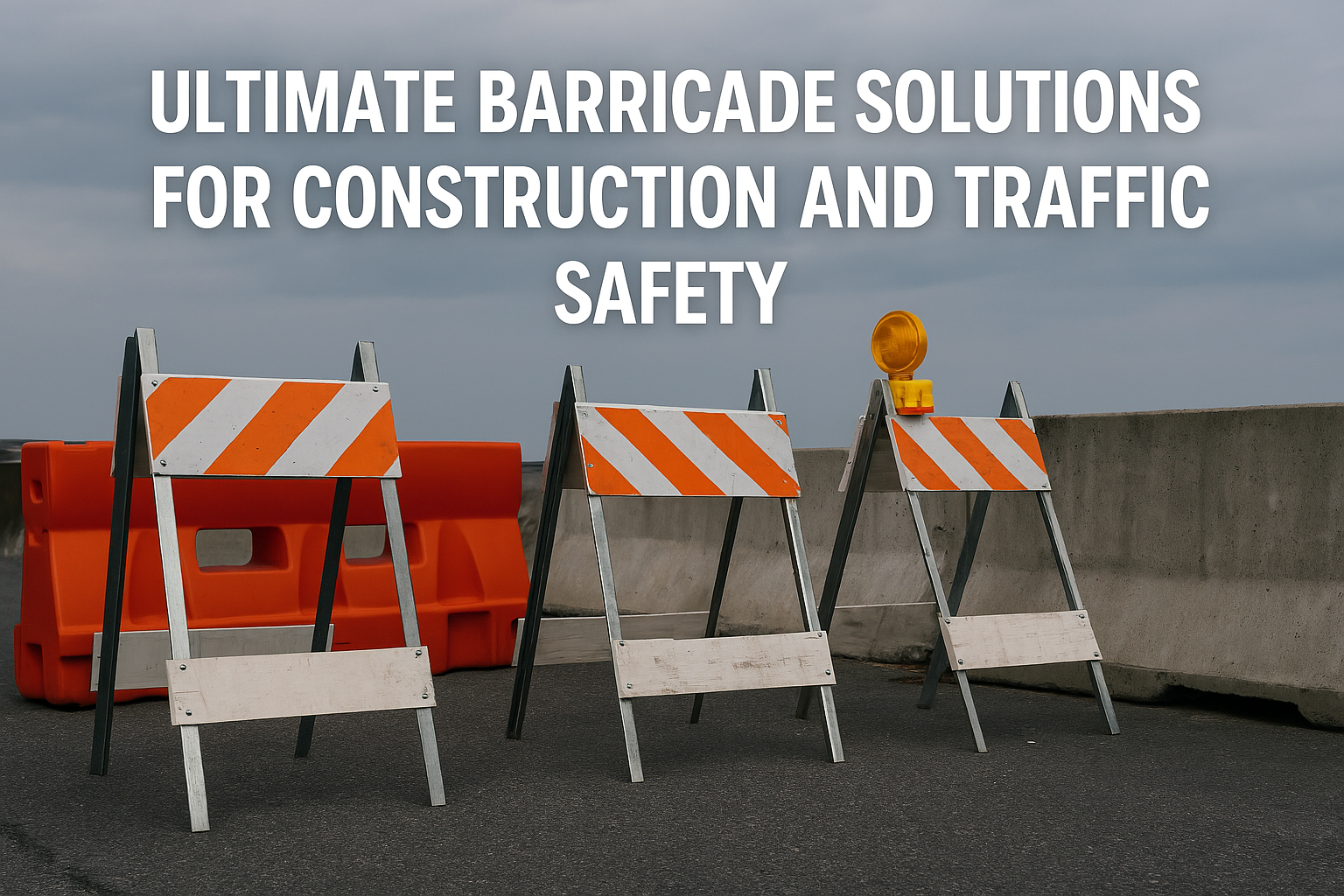Ultimate Barricade Solutions for Construction and Traffic Safety
A barricade is a safety tool used to block passage and control traffic or crowds, commonly seen on construction sites and roadways. Police use barricades to manage crowds and secure crime scenes, ensuring public safety during events or emergencies. In this article, we dive into the types of barricades, their specific uses, and how to choose the right one for your needs.
Key Takeaways
Barricades are essential safety structures used in construction, traffic management, and event control, with designs ranging from lightweight plastic to heavy-duty concrete.
The effectiveness of barricades is closely tied to their specific purposes, such as traffic control, worker safety on construction sites, and crowd management at events. A strong foundation is crucial in ensuring that barricades provide the necessary support and stability for these applications.
Innovations in barricade design, including sustainable materials and advanced technologies like AI integration, are enhancing their functionality and adaptability in various environments.
Understanding Barricades
Barricades serve a crucial role beyond being mere blocks. They are vital components that establish boundaries to regulate or prevent access, promoting safety and organization in diverse environments. When it comes to construction sites, the use of barricading is key in reducing risks, protecting both the workforce and the public from potential dangers. These barriers can vary widely, encompassing everything from basic plastic fences to heavy-duty concrete barricades tailored for intense usage scenarios. Barricade selection hinges on the unique demands posed by their intended application—whether it’s guiding vehicular flow, demarcating unsafe areas, or managing large groups during events—and sometimes involves closing off regions explicitly for enhanced security and safety measures.
Locations can be barricaded to control access and enhance safety during emergencies, protests, or other critical situations.
It’s important to acknowledge the range of materials and configurations employed in constructing barricades, as this underlines their adaptability. Concrete variants stand out due to their durability and are typically deployed where there is a need for high resistance against impacts. Conversely, lighter options like those made from plastic are chosen for attributes such as ease of movement and quick setup capabilities. Each type of barricade has been thoughtfully crafted with an eye toward ensuring protection while maintaining high visibility and practicality.
What is a Barricade?
A barricade is a physical barrier specifically designed to block or control the flow of traffic, pedestrians, or vehicles in a designated area. These barriers are indispensable in various scenarios, including construction sites, crowd control at events, and security operations. The term “barricade” has its roots in the French word “barrique,” meaning “barrel,” and has been part of the English lexicon since the 16th century.
Barricades can be either permanent or temporary, depending on their intended use and duration. They are constructed from a range of materials such as wood, metal, and plastic, each chosen for its suitability to the task at hand. Whether it’s guiding vehicles on a busy street, ensuring safe passage for pedestrians, or barricading a construction zone, these barriers play a crucial role in maintaining order and safety.
Types of Barricades
The barricade universe is expansive and diverse, encompassing various kinds that cater to specific needs based on their construction and the materials used. These barriers play a critical role in areas such as directing traffic flow, ensuring safety at construction sites, and managing crowds at events. For a barricade to be effective, it must be appropriately matched with its purpose.
Barricades help in directing the flow of traffic in a specific direction, ensuring smooth and organized movement.
Constructed from materials like steel, plastic, or concrete—each providing varying degrees of strength and visibility—barricades are designed for particular scenarios. In subsequent sections below this introduction, we will delve into three principal categories: those utilized for traffic control, ones needed for safeguarding construction zones, and barricades employed during gatherings to manage attendees efficiently. Each category possesses distinctive characteristics essential for success in its dedicated environment.
Traffic Barricades for Vehicles
Barricades play an essential role in regulating the flow of traffic and maintaining safety on roads. In areas with high levels of security, such as construction sites, sturdy metal barriers are utilized to guide vehicles effectively and safeguard those walking nearby. Barriers filled with water are also commonly employed due to their increased stability and prominence alongside streets. Their effectiveness is heightened by their bright colors and surfaces that often feature retroreflective materials for easy detection by motorists.
In locations where vehicular activity is intense, making barricades visible is paramount. The use of retroreflective substances on these structures significantly boosts their visibility, ensuring they stand out even during nighttime or inclement weather conditions. This enhanced visibility is vital in averting mishaps and confirming that drivers adhere to designated pathways, particularly within active construction zones or when streets have been shut down.
Construction Barricades
Barricades are essential for safeguarding construction sites, delineating pathways for vehicles to avoid confusion and potential mishaps. They serve as a protective shield for the workforce, allowing crucial response time should there be any low-speed impacts. By demarcating danger zones clearly, these bars help to prevent unauthorized entry and maintain orderliness and security within the construction area.
Various materials with unique benefits are utilized in creating construction barricades. Water-filled barriers can be moved easily while providing better visibility than conventional concrete blocks. Meanwhile, plastic options are not only lightweight, but typically come adorned with reflective stripes that make them straightforward to deploy while ensuring they stand out prominently.
The addition of water or sand enhances barrier stability by giving them sufficient heft to resist forceful collisions. For securing specific sections against intruders, heavy-duty steel bars offer an effective solution due to their robust nature.
Event Barricades
At events ranging from grand festivals to intimate local meet-ups, the utilization of barricades is crucial for managing crowds and maintaining safety. The key role that event barricades play lies in their ability to effectively and securely manage large numbers of attendees. The use of steel bars is especially beneficial due to their capacity for interconnection, creating a formidable barrier resistant to being easily displaced.
To delineate off-limits areas and steer the flow of people, organizers frequently deploy these barriers strategically throughout event spaces. Integrating swing gates within these setups enables regulated entry points while ensuring protection in areas experiencing heavy foot traffic. By clearly marking out designated spaces and preventing excessive crowding through such measures, they contribute significantly to enhanced safety protocols and the seamless execution of an array of events.
Barricade Materials and Features
Barricades are crafted from a variety of materials, each selected based on the intended use, durability, and cost considerations. Common materials include wood, metal, and plastic, each offering unique benefits. For instance, wooden barricades are often used for their sturdiness and ease of customization, while metal barricades provide robust support and longevity. Plastic barricades, on the other hand, are lightweight and easy to maneuver, making them ideal for temporary setups.
The design of barricades can vary, with popular styles including A-frame, T-frame, and panel-style configurations. Many barricades come equipped with additional features to enhance their functionality, such as reflective tape for increased visibility, warning signs to alert passersby, and locking mechanisms for added security. Customization options are also available, allowing for specific requirements in terms of size, shape, and color to be met, ensuring that the barricades are perfectly suited to their intended application.
Historical Significance of Barricades
Since the 16th century, barricades have been synonymous with public dissent and insurrection, becoming particularly prominent in early 19th-century movements like the July Revolution of 1830 in France. These structures were not only practical obstacles but also emblematic of unity across different social strata, embodying both a tangible means to hamper an adversary and an emblematic gesture towards political reform.
In various historical upheavals, erecting barricades transcended the mere act of assembling barriers. It was a powerful demonstration. Particularly during the French revolutions, they epitomized defiance against tyranny and embodied people’s aspirations for liberty. Barricades thus served two critical functions: as effective defensive measures and poignant icons of rebellion.
Students have historically used barricades during protests to make a stand, often entering buildings to barricade themselves as a form of collective action.
Benefits of Using Barricades
Utilizing barricades offers multiple practical advantages, as they improve the control of both traffic involving vehicles and pedestrians, markedly increasing safety for all. Barricades contribute to preventing mishaps by clearly marking designated areas and guiding movement paths in a specific direction, which is essential in facilitating secure passage for individuals and transport.
Barricades have evolved over time to integrate features that are sustainable and serve more than one purpose. Nowadays, it’s common to find them constructed with materials such as recycled plastics or environmentally friendly polymers. What’s more, some modern designs include digital displays that offer up-to-date information regarding vehicular flow and pedestrian activity—enhancing their value through technology-enhanced utility.
Contemporary multifunctional barricades can fulfill extra roles beyond simple crowd control. These may include functioning as public seating or contributing aesthetically to urban landscaping projects. These enhancements transform barriers into versatile assets within communal spaces.
How to Choose the Right Barricade
When choosing an appropriate barricade, it’s essential to consider the environment and intended use. Barricades tailored for events are often designed to be light and easily movable, allowing swift setup. These crowd control barriers offer customization options such as branding possibilities that increase visibility while promoting businesses at gatherings. The modular construction of these barricades facilitates rapid assembly and adaptability, serving various requirements.
A strong foundation is crucial for the stability and support of barricades, ensuring they perform effectively in various conditions.
Key considerations in selecting barricades include their ease of movement, weight consideration, and visual appeal. More portable models might necessitate extra stabilizing measures under windy conditions due to their lighter build. For occasions where presentation is critical, the decision may hinge on whether one prefers the look of materials like vinyl or metal based on both function and form.
Finally, evaluating ground surface conditions is imperative for ensuring a barricade’s stability and functionality. Designs with bridge feet tend to accommodate irregular surfaces more effectively.
Installation and Maintenance
The simplicity of installation and upkeep guarantees the functional durability of barricades. Many contemporary systems designed for barricading do not necessitate the use of power tools, allowing for a swift and straightforward setup process. For instance, it is possible to outfit a room measuring 500 square feet with such systems in merely an afternoon’s time, offering convenience to those employing these measures. Reflective sheeting is used on barricades to enhance their visibility under all kinds of weather conditions.
Police use barricades for quick and efficient setup during emergencies, ensuring public safety by managing crowds, securing crime scenes, and controlling traffic.
Materials that can withstand various weather conditions are utilized in constructing these bars, ensuring they stay reliable when exposed outdoors for prolonged periods.
Healthcare facilities such as Mercy General and St. Mary’s Children’s have successfully incorporated modular barricade setups during refurbishment activities while minimizing interference with patient care services. These instances underscore the critical role robust and adaptable barriers play in preserving continuity and safety throughout construction or renovation endeavors within active environments like hospitals.
Barricade Regulations and Compliance
Compliance with local and national regulations is paramount when it comes to the use of barricades. In the USA, for instance, the Manual on Uniform Traffic Control Devices (MUTCD) sets forth specific standards that barricades must meet, particularly those used in construction zones. These standards ensure that barricades are highly visible, durable, and safe, thereby minimizing risks to both workers and the public.
For crowd control, barricades must be designed to prevent injury and ensure public safety, often incorporating features like rounded edges and stable bases. In combat or military operations, barricades must meet stringent standards for durability and effectiveness, capable of withstanding harsh conditions and providing reliable protection. Proper installation and maintenance are crucial to ensure that barricades remain effective and safe throughout their use, underscoring the importance of adhering to regulatory guidelines.
Innovations in Barricade Design
Advances in barricade technology are consistently increasing their efficiency and adaptability. For instance, insulated barricades offer superior thermal insulation, creating a more comfortable climate for workers at construction sites during colder weather. The insulating power of these barriers can reach an R-Value as high as 4.1, providing substantial warmth by keeping areas up to 10 degrees Celsius warmer compared to the external environment—a considerable benefit in severe weather conditions.
Modern barricades are also utilized by students during contemporary protests, where they often engage in demonstrations by entering buildings and barricading themselves as a form of collective action.
In anticipation of future developments, it is expected that barricades might be equipped with AI capabilities to better regulate traffic flow and improve interactions with vehicles. Such cutting-edge improvements have the potential to transform how we employ barricades by rendering them more intelligent and responsive to live circumstances. These technological advancements hold great promise for enhancing both safety and operational efficacy across diverse environments ranging from active construction zones to congested city streets.
Barricade Rental and Purchase Options
When it comes to acquiring barricades, there are options to either rent or purchase them from specialized suppliers. Construction equipment rental companies and traffic supply stores offer a range of barricades for short-term or long-term rental, catering to various project requirements. This flexibility is particularly beneficial for temporary needs, such as construction projects or events.
For those requiring barricades on a more permanent or frequent basis, purchasing is a viable option. Construction companies and event organizers often invest in their own barricades, which can be customized to meet specific needs in terms of size, shape, and color. Suppliers frequently offer additional services, including delivery, installation, and maintenance, ensuring that the barricades are set up correctly and remain in optimal condition throughout their use.
By understanding the different materials, features, regulations, and acquisition options, one can make informed decisions about the most suitable barricade solutions for their specific needs. Whether for construction, traffic control, or event management, the right barricades are essential for ensuring safety and order.
Case Studies
Barricades have proven to be a significant tool throughout history and remain relevant today. Their use during the June Rebellion of 1832 in Paris exemplified their effectiveness as instruments of civil resistance, playing a pivotal role in combatting tyrannical rule. This method was subsequently embraced by various protest movements within the United States, indicating that barricades are universally recognized symbols of opposition. During these historical events, locations were often barricaded to control access and enhance safety, ensuring that strategic points were secured against adversaries.
In current times, barricades made of plastic serve another purpose: they’re employed at events with high visibility for promotional activities, offering organizations an opportunity to showcase their brands. These innovative applications across diverse sectors highlight how adaptable and essential barricades are both historically and now. They retain their value as strategic elements for controlling and shaping public areas whether it’s through demonstrations or advertising campaigns.
Summary
Barricades play a critical role in maintaining safety and organization across diverse environments, including construction zones and communal gatherings. Recognizing the various forms of barricades, acknowledging their historical importance, and appreciating their advantages is essential for informed utilization choices. A strong foundation is crucial for the effectiveness of barricades, ensuring they provide the necessary support and stability. As advancements proceed, these barriers are evolving to become more intelligent and adaptable, ensuring enhanced efficacy and protection moving forward. The significance of barricades will persist as an essential component in protecting individuals and assets while we expand our metropolitan areas.
Frequently Asked Questions
What are barricades used for in construction?
In construction, barricades play a critical role in bolstering safety measures by shielding against potential dangers and guiding vehicle routes in a specific direction, which helps to minimize disorientation at the site.
They are indispensable for upholding a safe work environment.
How do traffic barricades enhance road safety?
Traffic barricades enhance road safety by creating clear, visible barriers that guide vehicle movement and safeguard pedestrians, especially with their retroreflective materials for improved visibility at night.
What are the benefits of modern barricades?
Modern barricades provide improved safety, utilize sustainable materials, serve multiple functions, and can display real-time information, making them a versatile and effective solution for public safety.
How do event organizers use barricades?
During large events, organizers strategically deploy barricades to guide the flow of crowds and demarcate off-limits zones, thereby maintaining order and safety for attendees.
What innovations are being made in barricade design?
Advancements in the design of barricades concentrate on using materials that provide insulation for thermal defense, designing them to be modular for flexible configuration, and incorporating artificial intelligence technology to optimize traffic control.
The goal of these innovations is to boost the effectiveness and functionality of barricade systems.


